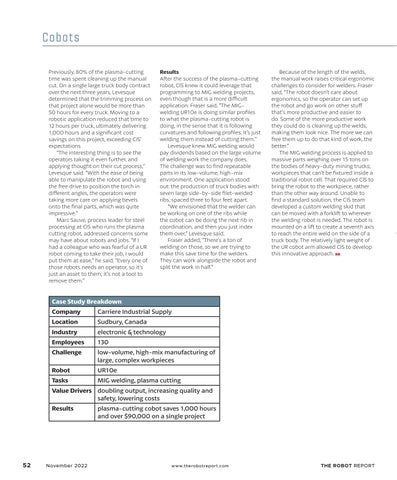Cobots Previously, 80% of the plasma-cutting time was spent cleaning up the manual cut. On a single large truck body contract over the next three years, Levesque determined that the trimming process on that project alone would be more than 50 hours for every truck. Moving to a robotic application reduced that time to 12 hours per truck, ultimately delivering 1,000 hours and a significant cost savings on this project, exceeding CIS’ expectations “The interesting thing is to see the operators taking it even further, and applying thought on their cut process,” Levesque said. “With the ease of being able to manipulate the robot and using the free drive to position the torch in different angles, the operators were taking more care on applying bevels onto the final parts, which was quite impressive.” Marc Sauve, process leader for steel processing at CIS who runs the plasma cutting robot, addressed concerns some may have about robots and jobs. “If I had a colleague who was fearful of a UR robot coming to take their job, I would put them at ease,” he said. “Every one of those robots needs an operator, so it’s just an asset to them; it’s not a tool to remove them.”
Results After the success of the plasma-cutting robot, CIS knew it could leverage that programming to MIG welding projects, even though that is a more difficult application. Fraser said, “The MIGwelding UR10e is doing similar profiles to what the plasma-cutting robot is doing, in the sense that it is following curvatures and following profiles; It’s just welding them instead of cutting them.” Levesque knew MIG welding would pay dividends based on the large volume of welding work the company does. The challenge was to find repeatable parts in its low-volume, high-mix environment. One application stood out: the production of truck bodies with seven large side-by-side filet-welded ribs, spaced three to four feet apart. “We envisioned that the welder can be working on one of the ribs while the cobot can be doing the next rib in coordination, and then you just index them over,” Levesque said. Fraser added, “There’s a ton of welding on those, so we are trying to make this save time for the welders. They can work alongside the robot and split the work in half.”
Because of the length of the welds, the manual work raises critical ergonomic challenges to consider for welders. Fraser said, “The robot doesn’t care about ergonomics, so the operator can set up the robot and go work on other stuff that’s more productive and easier to do. Some of the more productive work they could do is cleaning up the welds, making them look nice. The more we can free them up to do that kind of work, the better.” The MIG welding process is applied to massive parts weighing over 15 tons on the bodies of heavy-duty mining trucks; workpieces that can’t be fixtured inside a traditional robot cell. That required CIS to bring the robot to the workpiece, rather than the other way around. Unable to find a standard solution, the CIS team developed a custom welding skid that can be moved with a forklift to wherever the welding robot is needed. The robot is mounted on a lift to create a seventh axis to reach the entire weld on the side of a truck body. The relatively light weight of the UR cobot arm allowed CIS to develop this innovative approach. RR
Case Study Breakdown Company
Carriere Industrial Supply
Location
Sudbury, Canada
Industry
electronic & technology
Employees
130
Challenge
low-volume, high-mix manufacturing of large, complex workpieces
Robot
UR10e
Tasks
MIG welding, plasma cutting
Value Drivers doubling output, increasing quality and safety, lowering costs Results
52
November 2022
UR Cobot Case Study_11-22_Vs2.indd 52
plasma-cutting cobot saves 1,000 hours and over $90,000 on a single project
www.therobotreport.com
THE ROBOT REPORT
11/4/22 7:41 AM
